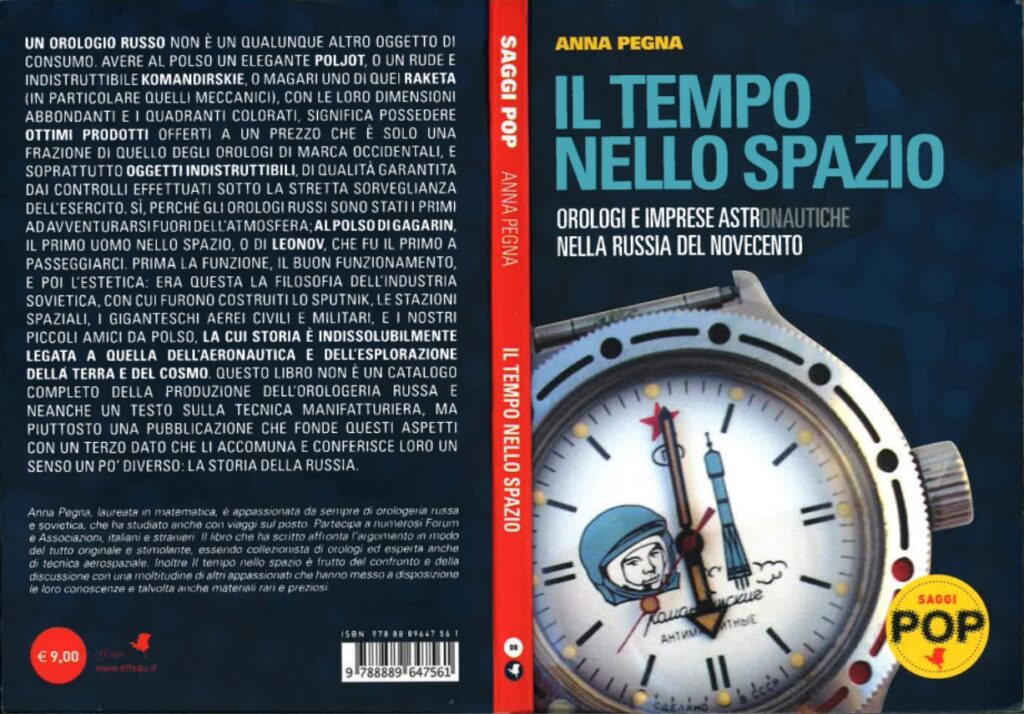“Il tempo nello spazio” by Anna Pegna is a book that has captured the interest of many collectors and enthusiasts of Russian and Soviet horology. Published by Effequ in 2010, this text offers a detailed exploration of watches and astronautic enterprises in 20th-century Russia, making it an essential work for those who wish to better understand the interplay between technology, history, and Soviet space adventures. The title in Italian translates to “The Time in Space” in English.

A Masterpiece Sought After by Collectors
“Il tempo nello spazio” is out of print and can only be found second-hand. Even the author, Anna Pegna, no longer has the original files, making a reprint impossible. This factor has increased the book’s value among collectors, making it a highly sought-after item.
A Detailed and Engaging Analysis
Chapter 1: The Beginnings
The first chapter, titled “Gli inizi” (“The Beginnings”), traces the history of Russian watchmaking from the Tsarist era to the October Revolution. 19th-century Russia is depicted as a primarily agricultural country with few industries and little tradition in watchmaking. The narrative focuses on early watchmaking experiences, such as that of Pavel Bure, who founded a factory in 1815 using Swiss movements. The contributions of pioneers like Piotr Vasil’evich Khautskij and Konstantin Tsiolkovskij, who laid the groundwork for future precision mechanics and Russian astronautics, are also highlighted.
Chapter 2: The First Factories of the New Regime
The second chapter examines the transformations that occurred after the October Revolution when the Soviet government recognised the importance of precision production. The acquisition and transfer of the American Dueber-Hampden factory to Russia marked the beginning of Soviet watch production. The establishment of the First State Watch Factory in Moscow and the introduction of early Soviet models like the Type-1 are described. This chapter also illustrates the initial difficulties and the need to develop an autonomous production independent of foreign technology.
Chapter 3: War-Time Watch Factories
The third chapter, “Le fabbriche di orologi di guerra” (“War-Time Watch Factories”), describes the crucial role of watchmaking during World War II. Soviet factories were relocated eastward to protect them from German attacks, focusing on producing military watches and precision instruments for aviation and the navy. The chapter recounts the story of the Zlatoust factory, which continued producing ammunition and parts for Katiusha rockets, and the Second Moscow Watch Factory, which moved to Chistopol. The strategic importance of precision watches in military operations is emphasised.
Chapter 4: Watch Factories in the Soviet System
The fourth chapter focuses on the organisation and management of watch factories within the Soviet system. Factories were not autonomous entities but part of a single state system. Each factory had its distinctive brands but often shared technologies and movements. This chapter explores how factories collaborated and integrated into the broader context of the Soviet planned economy.
Chapter 5: The Post-War Period
The fifth chapter, “Il dopoguerra” (“The Post-War Period”), describes the resumption of watch production after the war. Factories resumed mass production and introduced new models like the Pobeda. This chapter also examines the influence of German technology on Soviet chronographs and the role of war reparations in rebuilding the watch industry. The history of movements under LIP licence and the evolution of major factories like Kirova and Raketa are detailed.
Chapter 6: Men (and Women) in Space
This chapter offers an overview of Soviet space enterprises and the crucial role of watches in these missions. The stories of Yuri Gagarin, the first man in space, and the Shturmanskie watch he wore, along with key figures like Valentina Tereskova, the first woman in space, and Alexey Leonov, the first man to perform a spacewalk, are narrated alongside the watches that accompanied them.
Chapter 7: Beyond the Iron Curtain
The seventh chapter explores the spread and influence of Soviet watches beyond the USSR’s borders. The chapter details how these watches became popular in Eastern Bloc countries and were perceived in the West, highlighting export strategies and the international reputation of Soviet watches.
Chapter 8: Other Soviet Factories
This chapter focuses on other significant but less well-known Soviet watch factories. The histories of factories like Raketa, Chaika, Zarja, and Molnija and their unique contributions to Soviet horology are described. The peculiarities of each factory and their distinctive models are explored.
Chapter 9: After Khrushchev
The ninth chapter analyses the transformations in the Soviet watch industry following Khrushchev’s fall. It examines how Brezhnev’s policies influenced production and technological development. This chapter also describes the new models introduced during this period and the challenges faced by the industry.
Chapter 10: Watches of the 1970s
The tenth chapter focuses on the watches produced in the 1970s, a period of innovation and diversification. Iconic models like the Raketa Copernicus and Poljot Okean are described. The chapter examines design trends and emerging technologies of this decade.
Chapter 11: Watches of the 1980s
This chapter explores developments in Soviet watchmaking during the 1980s. The influence of the 1980 Moscow Olympics on watch production and the impact of political and social events on the industry are described. Models like Poljot and Vostok are discussed in detail.
Chapter 12: Spacecraft and Space Stations
The twelfth chapter offers an overview of Soviet space missions and the watches used aboard spacecraft and space stations. The chapter describes the role of watches in timing and coordinating space missions, highlighting the importance of precision and reliability.
Chapter 13: Epilogue
The final chapter, “Epilogo” (“Epilogue”), summarises the main themes of the book and reflects on the legacy of Soviet horology. The historical and cultural relevance of Soviet watches and their place in modern collecting are discussed. The chapter concludes with considerations on the importance of preserving this historical heritage.
A Must-Read for Enthusiasts
The book is highly praised for being well-written and engaging, providing not only technical details about the watches but also a rich historical narrative that contextualises technological evolution within the scope of Soviet space adventures. This book is a must-have for anyone passionate about Russian and Soviet horology, especially those interested in space exploration stories.
The Unique Appeal of Soviet Watches
One of the most fascinating aspects of the book is the description of Russian watches, known for their robustness and precision. These watches, offered at affordable prices, were the first to leave Earth’s atmosphere, accompanying astronauts like Gagarin and Leonov on their historic missions.
Conclusion
“Il tempo nello spazio” by Anna Pegna is a work that offers a unique perspective on Soviet horology and 20th-century space enterprises. Although out of print, this book remains a treasure for collectors and enthusiasts, representing a piece of history that combines engineering, adventure, and military history. If you haven’t read this book yet, searching for and acquiring it is an investment that will undoubtedly enrich your understanding and appreciation of Russian and Soviet horology.

